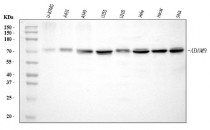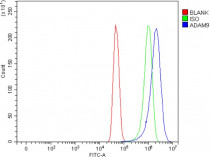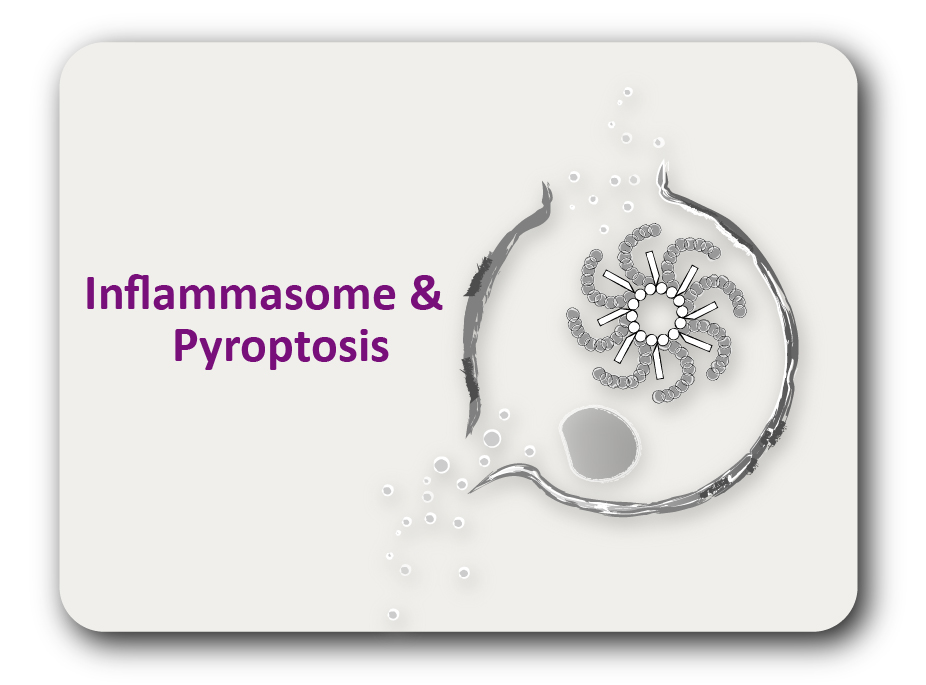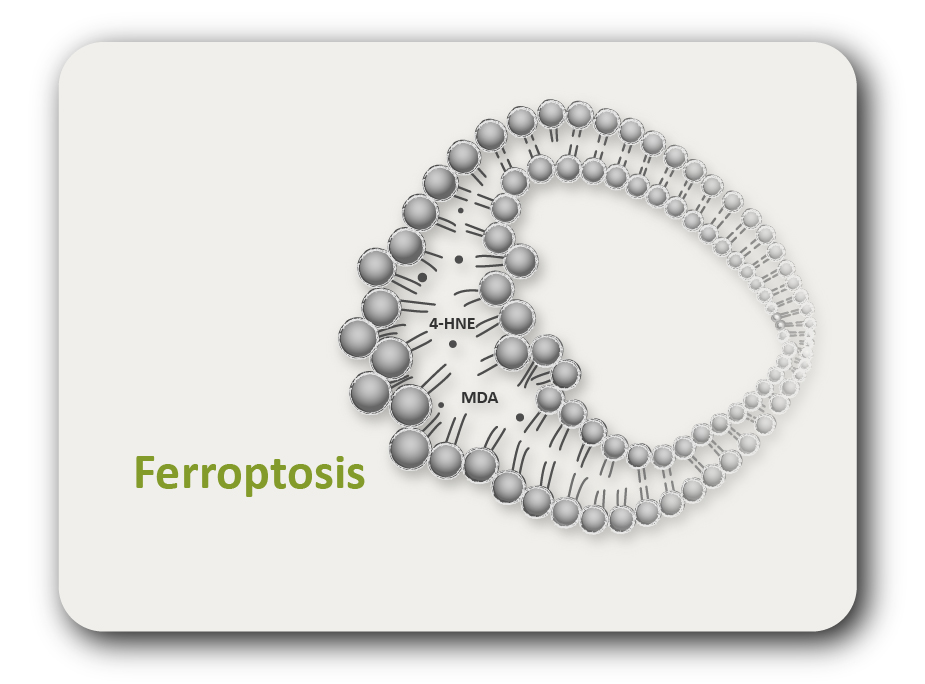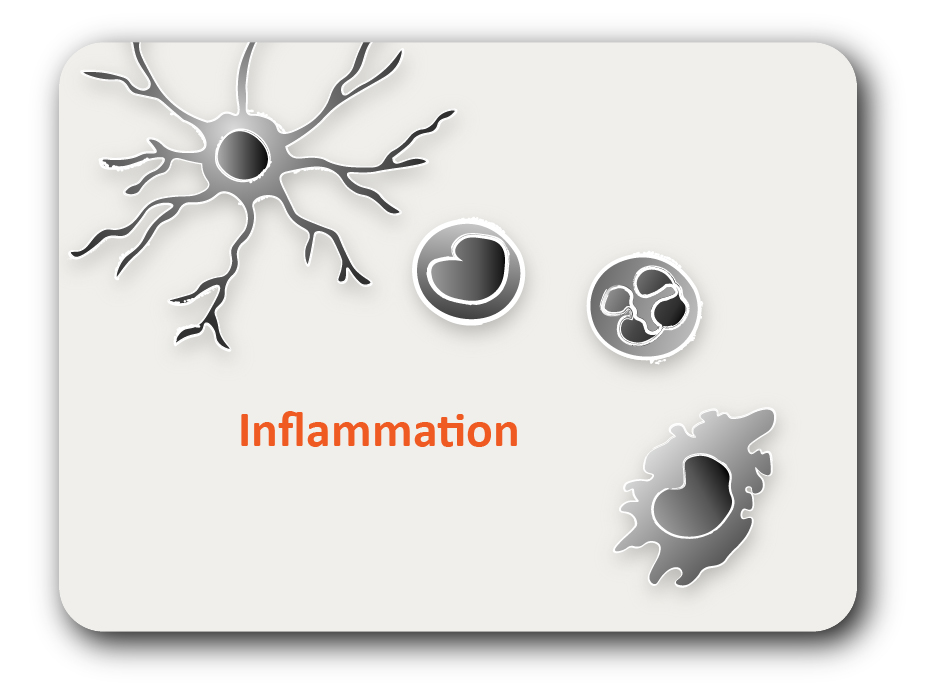ARG43613
anti-ADAM9 antibody
anti-ADAM9 antibody for Flow cytometry,Western blot and Human,Mouse,Rat
概述
| 产品描述 | Rabbit polyclonal antibody recognizes ADAM9 |
|---|---|
| 反应物种 | Hu, Ms, Rat |
| 应用 | FACS, WB |
| 宿主 | Rabbit |
| 克隆 | Polyclonal |
| 同位型 | IgG |
| 靶点名称 | ADAM9 |
| 抗原物种 | Human |
| 抗原 | Recombinant fragment protein of Human ADAM9. |
| 偶联标记 | Un-conjugated |
| Protein Full name | Disintegrin and metalloproteinase domain-containing protein 9 |
| 別名 | MDC9; Meltrin-gamma; ADAM 9; Metalloprotease/disintegrin/cysteine-rich protein 9; Disintegrin and metalloproteinase domain-containing protein 9; Cellular disintegrin-related protein; EC 3.4.24.-; CORD9; Mltng; MCMP; Myeloma cell metalloproteinase |
应用说明
| 应用建议 |
|
||||||
|---|---|---|---|---|---|---|---|
| 应用说明 | * The dilutions indicate recommended starting dilutions and the optimal dilutions or concentrations should be determined by the scientist. | ||||||
| 阳性对照 | A431, A549, U251, U2OS whole cell lysates; Mouse, rat liver | ||||||
| 实际分子量 | ~ 70-80 kDa (mature form), 100-115 kDa (pro-form) |
属性
| 形式 | Liquid |
|---|---|
| 纯化 | Affinity purification with immunogen. |
| 缓冲液 | 0.2% Na2HPO4, 0.9% NaCl, 0.05% Sodium azide and 4% Trehalose. |
| 抗菌剂 | 0.05% Sodium azide |
| 稳定剂 | 4% Trehalose |
| 浓度 | 0.5 mg/ml |
| 存放说明 | For continuous use, store undiluted antibody at 2-8°C for up to a week. For long-term storage, aliquot and store at -20°C or below. Storage in frost free freezers is not recommended. Avoid repeated freeze/thaw cycles. Suggest spin the vial prior to opening. The antibody solution should be gently mixed before use. |
| 注意事项 | For laboratory research only, not for drug, diagnostic or other use. |
生物信息
| 数据库连接 |
Swiss-port # Q13443 Human Disintegrin and metalloproteinase domain-containing protein 9 Swiss-port # Q61072 Mouse Disintegrin and metalloproteinase domain-containing protein 9 |
|---|---|
| 基因名称 | ADAM9 |
| 全名 | ADAM metallopeptidase domain 9 |
| 背景介绍 | This gene encodes a member of the ADAM (a disintegrin and metalloprotease domain) family. Members of this family are membrane-anchored proteins structurally related to snake venom disintegrins, and have been implicated in a variety of biological processes involving cell-cell and cell-matrix interactions, including fertilization, muscle development, and neurogenesis. The protein encoded by this gene interacts with SH3 domain-containing proteins, binds mitotic arrest deficient 2 beta protein, and is also involved in TPA-induced ectodomain shedding of membrane-anchored heparin-binding EGF-like growth factor. Several alternatively spliced transcript variants have been identified for this gene. [provided by RefSeq, Jul 2010] |
| 生物功能 | Probable zinc protease. May mediate cell-cell or cell-matrix interactions. Isoform 2 displays alpha-secretase activity for APP. [UniProt] |
| 细胞定位 | Cell membrane, Membrane, Secreted |
| 预测分子量 | 90.5 kDa |
| 翻译后修饰 | Proteolytically cleaved in the trans-Golgi network before it reaches the plasma membrane to generate a mature protein. The removal of the pro-domain occurs via cleavage at two different sites. Processed most likely by a pro-protein convertase such as furin, at the boundary between the pro-domain and the catalytic domain. An additional upstream cleavage pro-protein convertase site (Arg-56/Glu-57) has an important role in the activation of ADAM9. Phosphorylation is induced in vitro by phorbol-12-myristate-13-acetate (PMA). [UniProt] |
检测图片 (2) Click the Picture to Zoom In
-
ARG43613 anti-ADAM9 antibody WB image
Western blot: 30 µg of samples under reducing conditions. Human U-87MG whole cell lysates, Human A431 whole cell lysates, Human A549 whole cell lysates, Human U251 whole cell lysates, Human U2OS whole cell lysates, Human Hela whole cell lysates, Human HaCat whole cell lysates, Human SiHa whole cell lysates stained with ARG43613 anti-ADAM9 antibody at 0.5 µg/ml, overnight at 4°C.
-
ARG43613 anti-ADAM9 antibody FACS image
Flow Cytometry: U251 cells were blocked with 10% normal goat serum and then stained with ARG43613 anti-ADAM9 antibody (blue) at 1 µg/10^6 cells for 30 min at 20°C, followed by incubation with DyLight®488 labeled secondary antibody. Isotype control antibody (green) was rabbit IgG (1 µg/10^6 cells) used under the same conditions. An unlabelled sample (red) was also used as a control.
